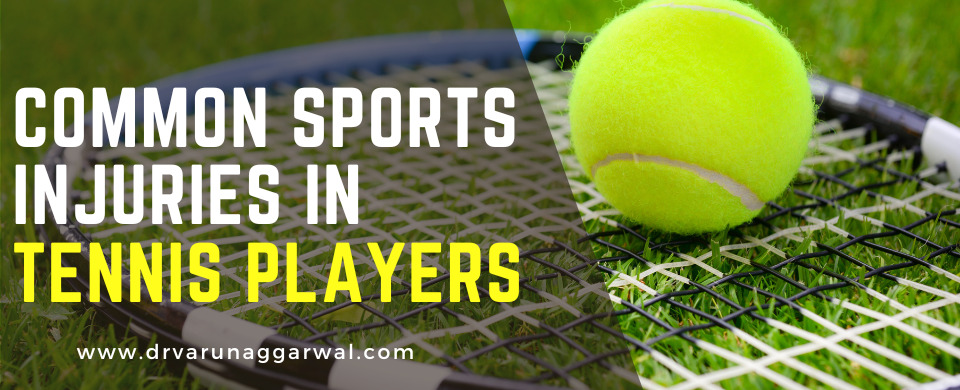Tennis is one of the most popular racket sports in the world. People of all age groups and genders love to play tennis. But, do you know the associated injuries of playing tennis? Keep reading this blog as today I am going to tell you some of the most common injuries among tennis players.
No matter whether you are a professional or non professional tennis player, you are at a risk of getting injured. The injuries among professional tennis players are usually due to playing a large number of tournaments. While, injuries among non professionals are normally due to inappropriate or insufficient physical and technique training. Let’s see the most common tennis injuries so that you can prevent them from affecting you.
Tennis Elbow
Tennis elbow is also known as lateral epicondylitis. It is a common injury among tennis players that occurs when a player repeatedly bends and flexes his elbow. It affects the tendons that connect the forearm muscle to the elbow, causing inflammation. Tennis elbow becomes inflamed on the inside, unlike golf elbow, which happens on the outside. If you develop a tennis elbow, you may suffer pain or burning on the outside of your elbow, along with a decreased grip.
Tennis elbow can be avoided by properly strengthening this muscle and the muscles around it, as well as following a regular warm-up routine. It’s also possible to avoid this by paying attention to technical aspects like grip size and technique.
Torn Rotator Cuff
The shoulder is often prone to wear and tear while playing tennis. Your rotator cuff will naturally wear away as you move your shoulders during tennis training and matches. So, a torn rotator cuff could be a chronic injury resulting from long-term overuse. However, it can also be an acute injury triggered by sudden stress.
With a torn rotator cuff, patients will feel extremely weak in the shoulder. It may also cause tender feelings, as well as difficulty moving the arms.
A doctor usually analyses the demonstrated range of motion to determine a torn rotator cuff.
Physical or occupational therapy is the first line of defence for a torn rotator cuff. These therapies will focus on regaining strength and muscle mass. The doctor may also suggest different activities to help you rebuild strength. When nonsurgical methods fail, arthroscopy repair becomes a possible alternative.
Tennis Knee: Patellar Tendonitis
Patellar tendonitis, sometimes known as jumper’s knee, is another common injury among tennis players. Tennis players commonly put a lot of stress on their knees by jumping and landing repeatedly. Landing on the surface, particularly abrasive surfaces (such as cement), and pushing yourself to the limit might lead to injury. Swelling and pain usually begin just below the knee.
Patellar tendonitis can be detected by a doctor based on pain, inflammation, and range of motion in the knee. The reduction of inflammation within the knee is the first step of the treatment. Patients can benefit from light stretching exercises to help them rebuild their muscles and general strength. The stretching exercises will also assist you in resuming more strenuous activities gradually.
Achilles Tendon Rupture
The Achilles tendon connects the heel to the calf muscle, allowing people to perform high-intensity activities. Therefore, the Achilles tendon is important for jumping required to reach the tennis ball. Chronic overuse and inflammation make this injury more prevalent. However, the rupture of the Achilles tendon will be clear, with a loud snap.
This injury is especially dangerous for players who suddenly start playing tennis on a regular basis. Resuming a previous workout habit without sufficient training after months of rest. The most effective treatment is a surgical procedure in which the surgeon reattaches the two tendons.
Stress Fractures in the Back
The spine can be harmed by serving. The lower back is put under a lot of strain when you hyperextend your back and bend to the side. It may lead to spondylolisthesis, in which the vertebrae shift forward, or to spondylolysis, in which the interarticularis separates. This indicates that the vertebra is no longer securely placed in place. Continuing this physical activity causes more stress, although rest can help to relieve pain. The majority of patients will have pain or stiffness in the middle of their back or in their legs.
The nonsurgical treatment of stress fractures focuses on immobilizing the spine. Therefore, back braces and casts are two popular choices. While it is important to maintain some amount of modest activity, most doctors would advise against lifting. Patients with stress fractures may also benefit from physical therapy. When nonsurgical methods fail, minimally invasive spine surgery is used to completely repair the injury.
Click here to contact for more information


